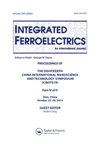White Light Emission and Judd-Ofelt Analysis of Dy 3+ Doped Mixed Alkali Borate Glass for W-LEDs Material
IF 0.7
4区 工程技术
Q4 ENGINEERING, ELECTRICAL & ELECTRONIC
引用次数: 0
Abstract
AbstractThe Dy3+ doped lithium sodium potassium borate glasses with white light-emitting were prepared by the melt quenching technique. In this work, optical, photoluminescence properties and Judd-Ofelt analysis of borate glasses have been investigated. For optical properties, Dy3+ doped glasses showed the absorption in visible and near-infrared region, which originate from 6H15/2 ground state to higher state. While the luminescence properties of Dy3+ doped glasses, the emission spectra were presented more intense at 484 nm (blue light) and 574 nm (yellow light) which are essential for white light emitting materials, whilst decay time decrease with an increase of Dy2O3 contents. The emission intensity of Dy3+ doped glasses were enhanced by adding Dy2O3 concentrations until 0.5 mol%, after that the emission intensities were decreased due to the concentration quenching effect. Judd-Ofelt is analyzed by using the absorption and photoluminescence results, The stimulated emission cross-section has been investigated in this work. The CIE 1931 chromaticity investigation shows that Dy3+ doped glass emitted light with white color. Hence, these glasses may be suitable candidates for use in W-LEDs material.Keywords: Alkali borate glassdysprosiumJudd-Ofeltwhite light emission AcknowledgmentsT.S. would like to acknowledge supports from Faculty of Science and Technology, Rajamangala University of Technology Phra Nakhon (RMUTP) and Thailand Science Research and Innovation (TSRI). Our thanks are also grateful to the Center of Excellence in Glass Technology and Materials Science (CEGM), Faculty of Science and Technology, Nakhon Pathom Rajabhat University.Disclosure StatementNo potential conflict of interest was reported by the author(s).Additional informationFundingThis project is funded by National Research Council of Thailand (NRCT) (Contract No. N41A650404) and Cerntek Company Limited.掺dy3 +混合碱硼酸玻璃用于w - led材料的白光发射及juded -毡分析
摘要采用熔体猝灭技术制备了掺Dy3+硼酸锂钠钾玻璃。本文研究了硼酸盐玻璃的光学、光致发光特性和Judd-Ofelt分析。光学性质方面,掺杂Dy3+的玻璃在可见光和近红外区均有吸收,吸收源为6H15/2基态到更高态。而Dy3+掺杂玻璃的发光特性,在白光材料必需的484 nm(蓝光)和574 nm(黄光)处的发射光谱更为强烈,衰减时间随着Dy2O3含量的增加而缩短。添加Dy2O3浓度至0.5 mol%时,Dy3+掺杂玻璃的发射强度增强,之后由于浓度猝灭效应,发射强度降低。利用吸收和光致发光结果对Judd-Ofelt进行了分析,并研究了受激发射截面。CIE 1931色度测试表明,掺杂Dy3+的玻璃发出白色的光。因此,这些玻璃可能适合用于w - led材料。关键词:碱硼酸玻璃;镝;judd - ofelet;感谢科学技术学院、拉贾曼加拉科技大学(RMUTP)和泰国科学研究与创新(TSRI)的支持。我们也要感谢那空佛统拉贾哈特大学科技系玻璃技术与材料科学卓越中心(CEGM)。披露声明作者未报告潜在的利益冲突。本项目由泰国国家研究委员会(NRCT)资助(合同编号:N41A650404)和Cerntek Company Limited。
本文章由计算机程序翻译,如有差异,请以英文原文为准。
求助全文
约1分钟内获得全文
求助全文
来源期刊

Integrated Ferroelectrics
工程技术-工程:电子与电气
CiteScore
1.40
自引率
0.00%
发文量
179
审稿时长
3 months
期刊介绍:
Integrated Ferroelectrics provides an international, interdisciplinary forum for electronic engineers and physicists as well as process and systems engineers, ceramicists, and chemists who are involved in research, design, development, manufacturing and utilization of integrated ferroelectric devices. Such devices unite ferroelectric films and semiconductor integrated circuit chips. The result is a new family of electronic devices, which combine the unique nonvolatile memory, pyroelectric, piezoelectric, photorefractive, radiation-hard, acoustic and/or dielectric properties of ferroelectric materials with the dynamic memory, logic and/or amplification properties and miniaturization and low-cost advantages of semiconductor i.c. technology.
 求助内容:
求助内容: 应助结果提醒方式:
应助结果提醒方式:


